The beautiful and delicate pink flowers name is one of nature’s most stunning creations. There are various types of pink flowers, each with its unique fragrance and shape. The pink rose is a popular flower that is often associated with love and romance.
One of the most popular types of pink flowers is the cherry blossom. It blooms during springtime and is a symbol of renewal and the transience of life. Other pink flowers that are commonly found in gardens and floral arrangements include the pink peony, pink tulip, and pink carnation.
Pink flowers are also used in many cultural celebrations around the world, such as the Hanami festival in Japan, where people gather to admire the beauty of the cherry blossom. Pink flowers are always a beautiful and joyful sight.
Pink Flowers Name
Azalea
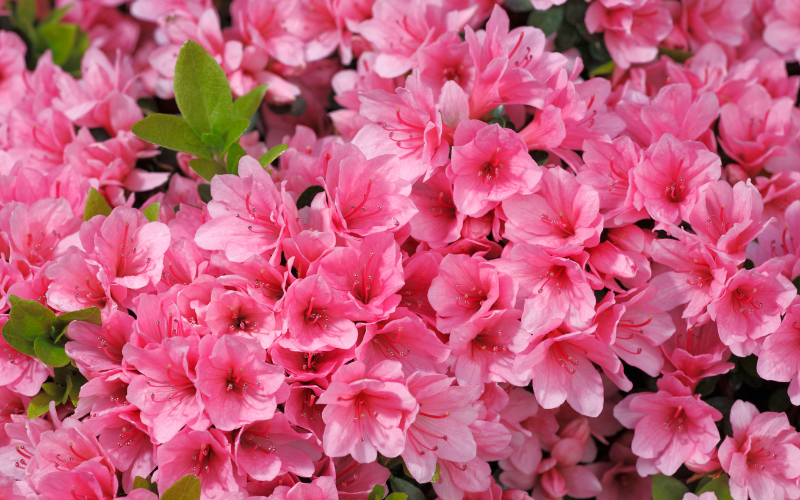
Azaleas are stunning flowering plants that bloom in spring with a variety of colors such as pink, red, white, and yellow. They are a popular choice among gardeners due to their low maintenance requirements.
Azaleas are a type of shrub that can thrive in partial shade to full sun. They require acidic soil that is rich in organic content. When planting azaleas, it is important to ensure that they are not planted too deeply and that the soil is well-drained to prevent root rot. Pruning is also essential to maintain their shape and encourage new growth. With proper care, these beautiful shrubs can add color and vibrancy to your garden for many years.
| Scientific Name | Rhododendron |
| Native Range | Asia, Europe, and North America |
| Flowering Season | Late winter to early spring |
Nasturtium
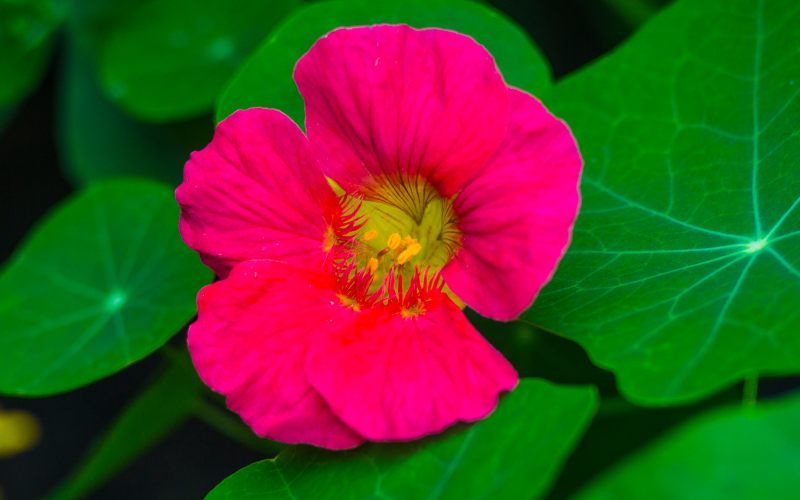
Nasturtium is a versatile and beautiful flowering plant that originates from South America. Gardeners love its vibrant colors such as orange, yellow, and red. Interestingly, nasturtium is not only visually appealing, but it’s also an edible plant. Both the leaves and flowers of the plant have a slightly peppery taste similar to arugula, making it a perfect addition to salads or as a dish garnish.
Nasturtium is a plant that offers various health benefits. It is rich in vitamin C and has antibacterial properties, making it an excellent addition to natural remedies for colds and flu. Additionally, this versatile plant is great for attracting beneficial insects like bees and butterflies to your garden.
| Scientific Name | Tropaeolum |
| Native Range | South America and Central America, from Mexico to Chile |
| Flowering Season | Late spring or early summer |
Ivy Geranium
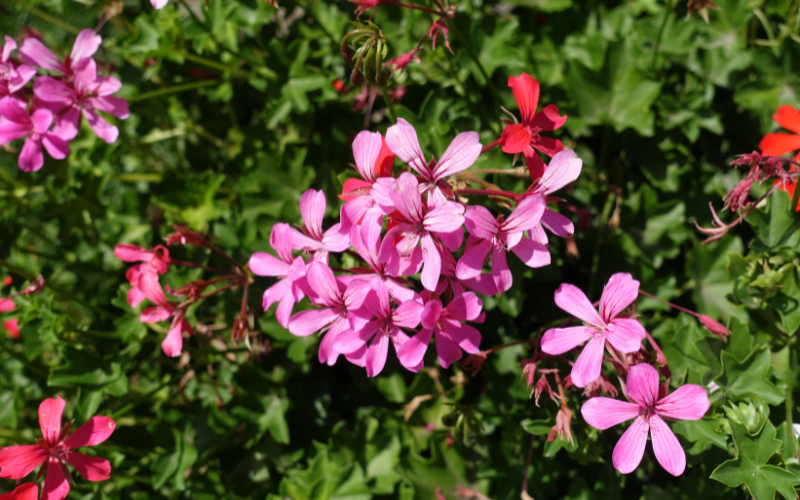
The Ivy Geranium is a stunning and adaptable flowering plant that originates from South Africa. Its scientific name is Pelargonium peltatum and it is commonly referred to as Ivy Leaf Geranium owing to its ivy-like foliage. Ivy Geraniums are available in various sizes, colors, and forms, making them popular with both gardeners and landscapers.
Ivy Geraniums are versatile plants that thrive in both full sun and moderate shade. They can be planted in hanging baskets, window boxes, or directly in the ground, making them a popular choice for adding color and texture to any garden or outdoor space. With their flowing foliage and delicate blossoms, these plants are a beautiful addition to any landscape. One of the best things about Ivy Geraniums is that they require minimal maintenance, which makes them an excellent choice for both experienced and novice gardeners alike.
| Scientific Name | Pelargonium peltatum |
| Native Range | South Africa |
| Flowering Season | Summer |
Firecracker Flower
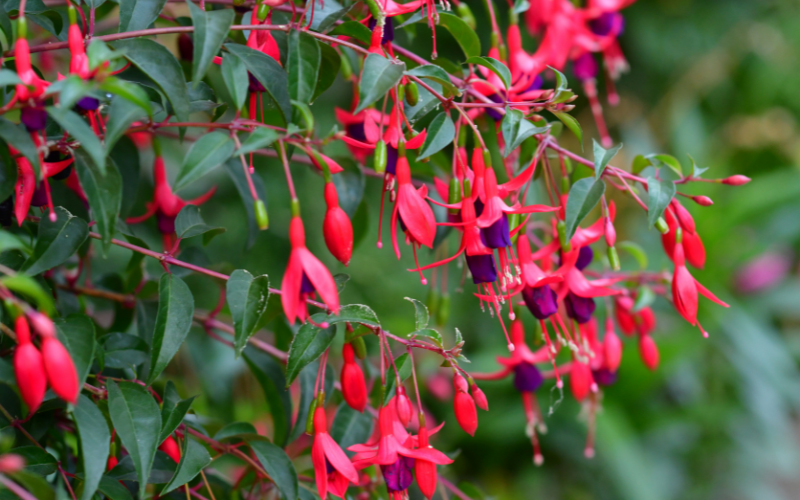
Firecracker Flower, also known as Crossandra, is a beautiful and vibrant plant species that is native to tropical regions of Africa and Asia. Its unique name comes from its shape, which is similar to a tiny firework explosion.
This plant is popular among gardeners due to its shimmering, orange flowers that bloom throughout the year. It is a low-maintenance plant that requires minimal care and can easily grow in warm and humid climates. The Firecracker Flower is not only a beautiful addition to any garden, but it also has medicinal properties. Its leaves and flowers have been used in traditional medicine to treat various ailments such as fever, headache, cough, and skin rashes. It is believed to have anti-inflammatory and antimicrobial properties as well..
| Scientific Name | Crossandra infundibuliformis |
| Native Range | Southern India and Sri Lanka |
| Flowering Season | Late spring or early summer until early autumn |
Gaura
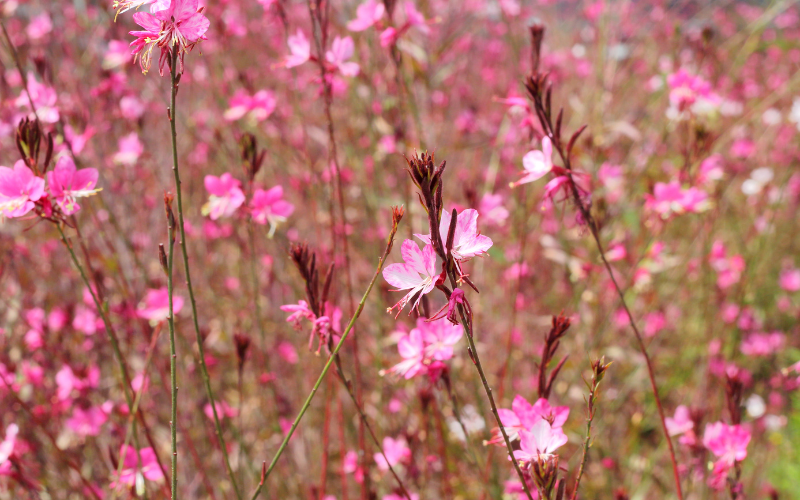
Gaura is a beautiful flower native to North America that is now grown all over the world for its natural beauty and elegance. The flowers on the Gaura plant bloom in late spring and last through the summer. They can be white, pink, or a beautiful combination of the two.
Gaura is a resilient plant that can flourish in various climates, and is a favored choice among gardeners for its capacity to draw in butterflies and hummingbirds. Gaura is also known for being an easy-to-maintain plant that doesn’t require much attention to produce a profusion of flowers. Therefore, it is an excellent option for those who enjoy gardening but have limited time to spare.
| Scientific Name | Oenothera lindheimeri |
| Native Range | Texas and Louisiana |
| Flowering Season | Mid-late spring in warm winter areas, late spring or early summer in cooler areas |
Lantana
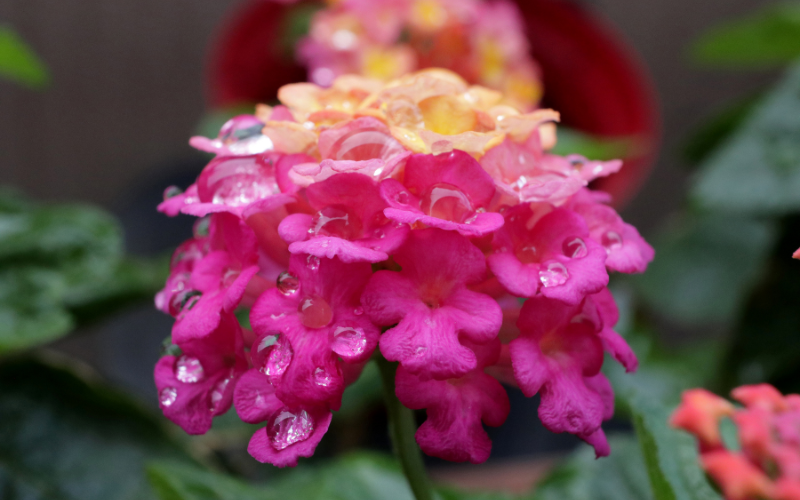
Lantana flowers are a beautiful and popular garden plant that is native to the tropical regions of the Americas and Africa. Their brightly colored flowers come in shades of red, orange, yellow, pink, and purple.
They are also known for their sweet and fruity scent, which is attractive to bees, butterflies, and other pollinators. Lantana flowers are simple to cultivate and care for because they require little upkeep and are resistant to heat and stress. They are also very versatile and can be grown in a variety of different settings, including as a ground cover, in a hanging basket, or as a hedge.
| Scientific Name | Lantana |
| Native Range | Central and South America |
| Flowering Season | Late spring or early summer |
Bee Balm
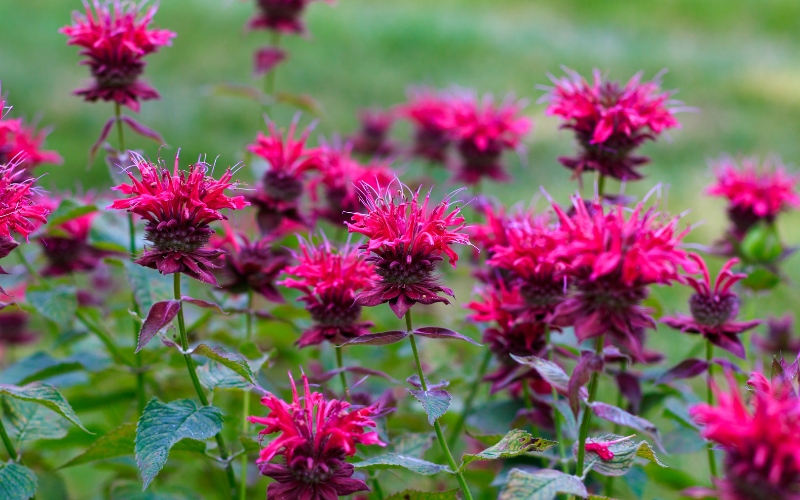
Bee balm is a strikingly beautiful flower that is renowned for its vibrant color and delightful fragrance. It belongs to the mint family and has been used for medicinal purposes for centuries. The flower is frequently included in herbal teas because it contains thymol, a natural antiseptic, and carvacrol, which is known for its antioxidant properties.
The flower is popular among gardeners because it attracts bees and butterflies, hence its name. In terms of appearance, the flower can range from bright pink to deep red or purple. This unique shape and vibrant color make it a standout addition to any garden.
| Scientific Name | Monarda |
| Native Range | Eastern North America from Maine west to Ontario and Minnesota, and south to northern Georgia |
| Flowering Season | Summer |
Lathyrus
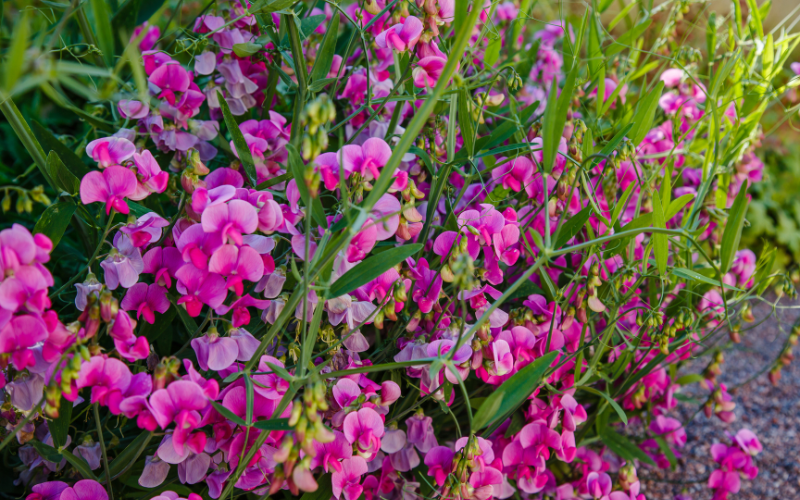
Lathyrus, commonly known as sweet pea, is a flowering plant belonging to the Fabaceae family. These beautiful flowers have a sweet fragrance and come in a range of colors, including white, yellow, pink, purple, and blue.
Sweet peas are a popular flower choice for gardens, adding elegance and charm. They’re also commonly used for decorative purposes, such as in wedding bouquets and centerpieces. Not just beautiful, sweet peas are also easy to grow. They thrive in well-drained soil with adequate sunlight, and with regular watering, they can bloom throughout the summer.
| Scientific Name | Lathyrus |
| Native Range | Europe, Asia, North, and South America |
| Flowering Season | Summer |
Red Feathers

The Red Feathers flower, a beautiful plant that belongs to the Borage family, is native to the Mediterranean region. It is characterized by its bright red, feathery blooms, which attract bees and butterflies. The plant can grow up to 60 centimeters tall and has long, narrow leaves with a slightly hairy texture.
The Red Feathers flower is known for blooming from spring to early summer and requires well-draining soil and plenty of sunlight to thrive. This flower holds a significant cultural value in Iran, where its petals are used to prepare a traditional tea that is believed to possess medicinal properties. The tea is known to help with anxiety, stress, high blood pressure, and heart disease.
| Scientific Name | Echium amoenum |
| Native Range | Iran’s Caucasus Mountains |
| Flowering Season | Summer |
Wisteria
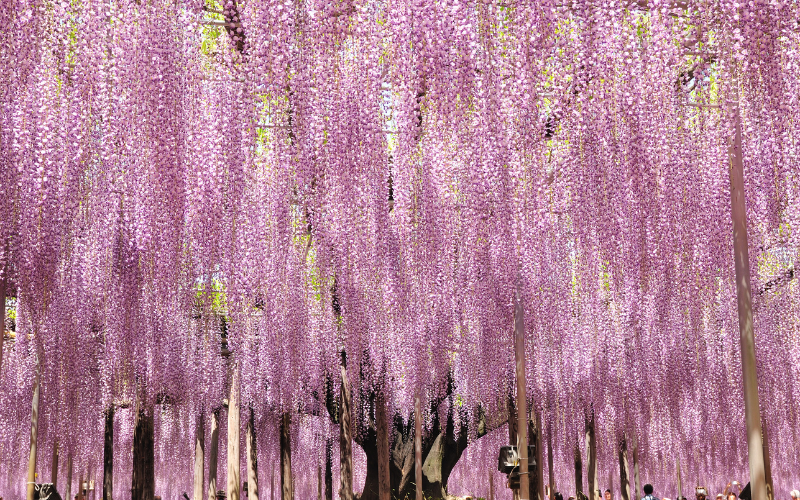
The wisteria flower is a beautiful and fragrant flowering plant that is native to Asia, particularly China, Korea, and Japan. It is a climbing plant that can grow up to 30 feet in length and produces long, drooping clusters of flowers that can range in color from white, pink, lavender, or blue.
The wisteria flower is renowned for its delicate and sweet fragrance, capable of filling an entire garden. It is a highly sought-after plant for trellises, pergolas, and archways, as it climbs and creates a stunning visual display. The wisteria flower holds great cultural significance in many parts of the world, often symbolizing love, beauty, and longevity. Additionally, it is commonly used in traditional Chinese medicine for its medicinal properties.
| Scientific Name | Wisteria |
| Native Range | China, Japan, Korea, Vietnam, southern Canada, the Eastern United States, and north of Iran |
| Flowering Season | Spring or summer |
Abilene Early Large
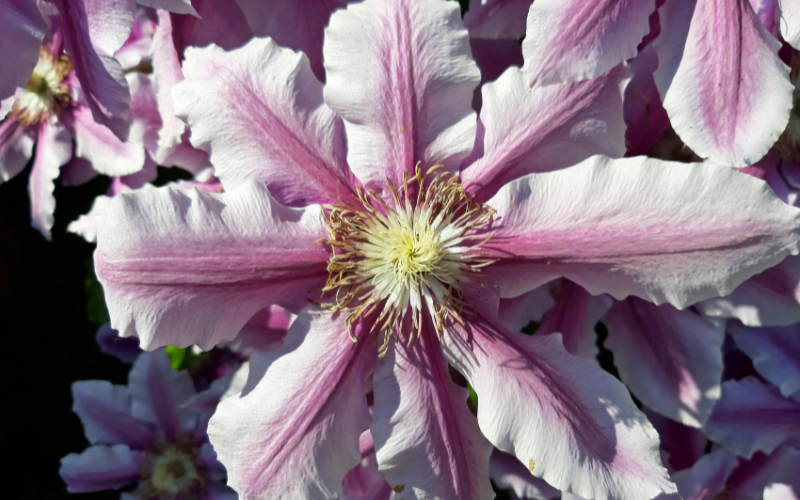
The Abilene Early Large Flower, also known as Abilene, is a stunning and vibrant variety that blooms early and would make a delightful addition to any garden.
The flower is quite large and boasts a beautiful range of colors, spanning from soft pastels to bold and vibrant hues. The Abilene Early Large Flower is certain to leave a lasting impression with its remarkable size, stunning colors, and delightful fragrance.
| Scientific Name | Clematis ‘Abilene’ |
| Native Range | Japan |
| Flowering Season | Summer |
Beacon Rose Impatiens
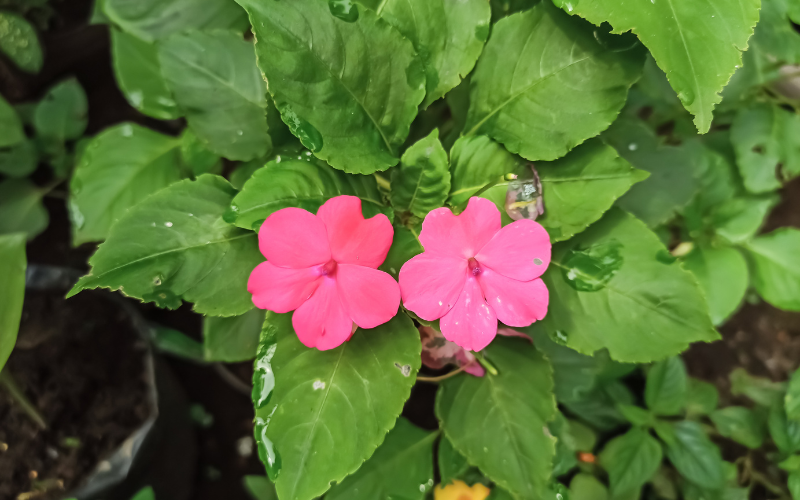
The Beacon Rose Impatiens flower is a stunning and vibrant plant. It is native to East Africa. The plant typically grows to a height of 6 to 24 inches (15 to 60 cm), depending on the variety. The flowers are typically single or double and come in a wide range of colors, including shades of red, pink, orange, white, and purple.
Some varieties may have bi-colored or multi-colored blooms. It is commonly used as a bedding plant, in containers, hanging baskets, and as a ground cover.
| Scientific Name | Impatiens walleriana |
| Native Range | East Africa |
| Flowering Season | Late spring or early summer |
Angel’s Fishing Rod
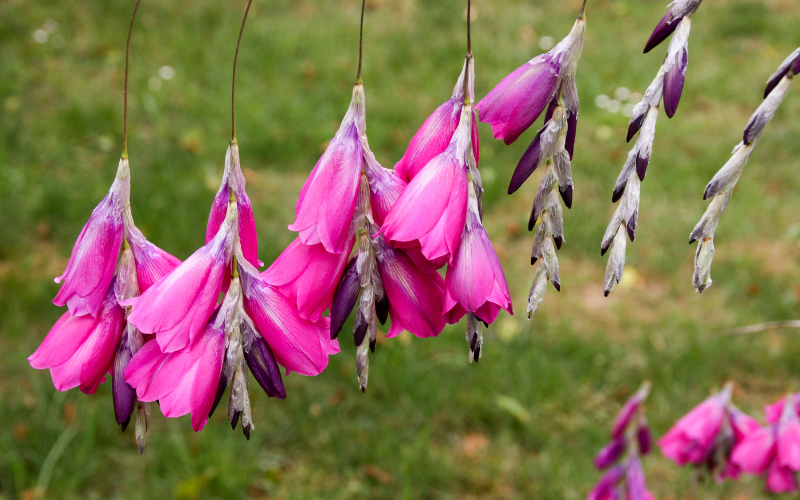
Angel’s Fishing Rod, scientifically known as Dierama pulcherrimum, is a charming flowering plant native to South Africa. It comes in a range of colors, including various shades of pink, purple, and white.
The plant prefers well-draining soil and a sunny to partly shaded location. With proper care, Angel’s Fishing Rod can be a long-lived perennial in suitable growing conditions.
| Scientific Name | Dierama pulcherrimum |
| Native Range | South Africa |
| Flowering Season | Late spring to early summer |
Cabaret Pink Star Calibrachoa
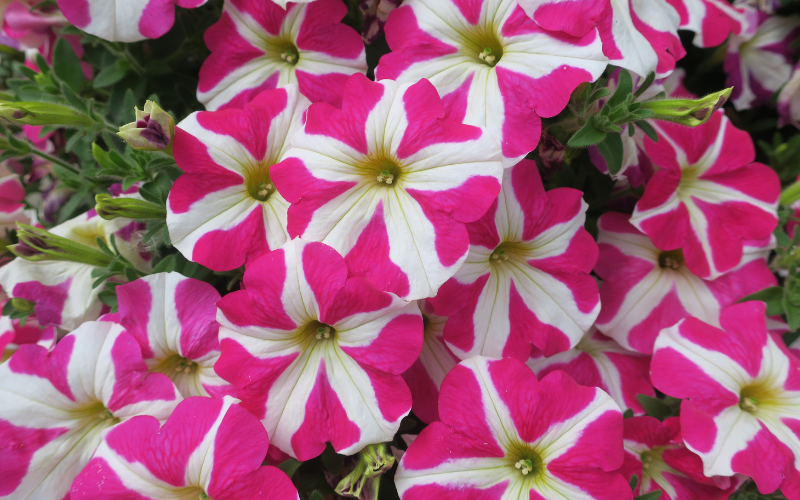
The Cabaret Pink Star Calibrachoa is a vibrant plant with star-shaped flowers in bright pink. It thrives in full sun to part shade and well-draining soil.
Calibrachoa is a low-maintenance plant that is ideal for hanging baskets, containers, or ground cover due to its compact growth habit.
| Scientific Name | Calibrachoa x hybrida ‘Cabaret Pink Star |
| Native Range | South America |
| Flowering Season | Late spring to the first frosts |
Anastasia Passion
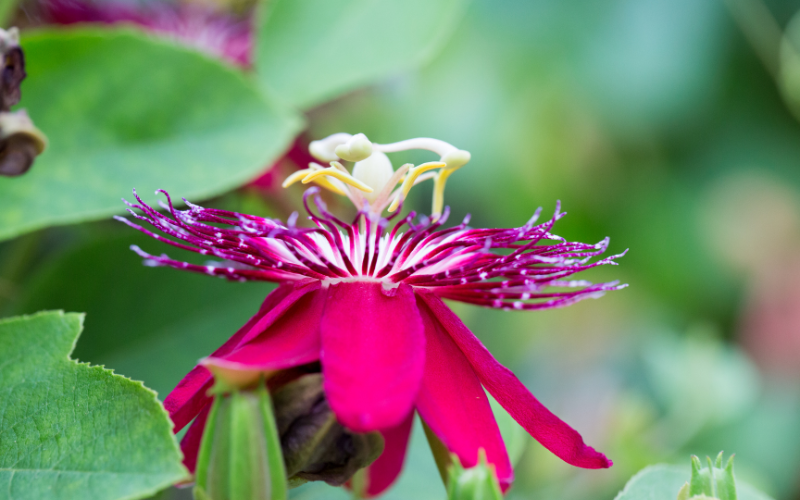
Anastasia Passion Flower, also known as Passiflora incarnata, is a stunning plant native to the southeastern United States. It can grow up to 10-20 feet (3-6 meters) in length.
The inner corona varies in color from white, lavender, to pink depending on the specific variety, while the outer petals are typically purple.
| Scientific Name | Passiflora ‘Anastasia’ |
| Native Range | Brazil, Argentina, Paraguay, and throughout Central America |
| Flowering Season | Spring and fall |
Cecile Brunner Climbing Rose
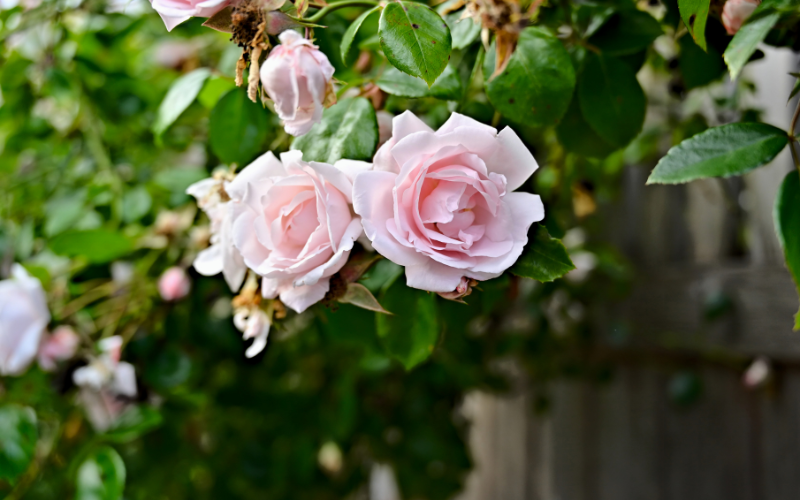
The Cecile Brunner Climbing Rose, also known as Climbing Cecile Brunner or The Sweetheart Rose, is delicate and charming with pale pink or light blush-colored flowers.
Climbing Cecile Brunner can grow up to 12-15 feet tall and blooms in spring to early summer.
| Scientific Name | Rosa x ‘Cecile Brunner’ |
| Native Range | Does not have a specific native range in the wild |
| Flowering Season | Spring through fall |
Annual Phlox
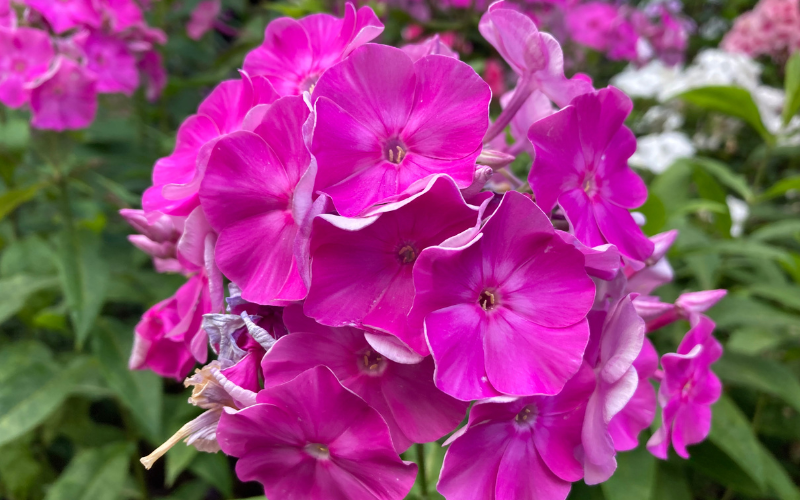
The Phlox flower is an annual plant that is scientifically known as Phlox drummondii. It is native to Texas and surrounding areas in the United States and is known for its stunning and vibrant blooms. The flowers come in a wide range of colors, including shades of pink, red, purple, lavender, white, and bicolor combinations.
The plant has a compact, upright growth, reaching heights of 6-18 inches and spreading 6-12 inches wide.
| Scientific Name | Phlox drummondii |
| Native Range | Texas to Alabama and Florida and as far north as Minnesota |
| Flowering Season | Early spring right through the heat of summer |
Elizabeth Clematis
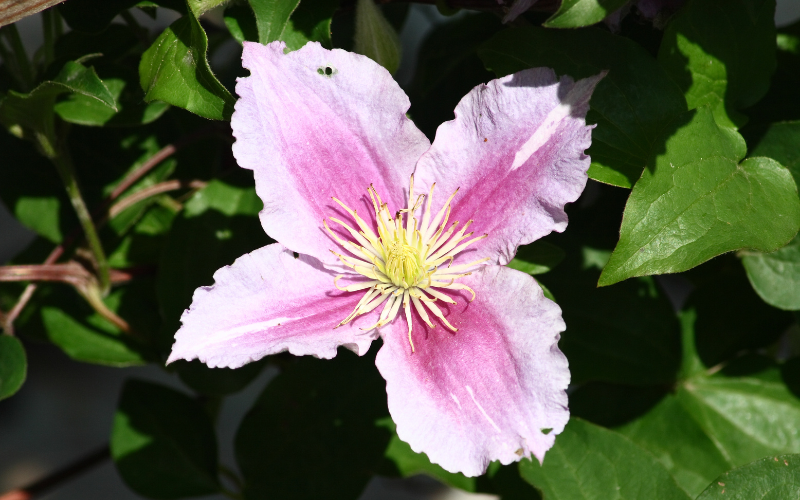
The Elizabeth Clematis is a beautiful plant that displays large, velvety petals in a delicate shade of blush pink. When its petals unfurl, they reveal an intricate pattern of pale yellow stamens that adds a touch of whimsy to its overall appearance.
During the summer months, its visually captivating flowers emit a sweet fragrance that attracts butterflies.
| Scientific Name | Clematis Sarah Elizabeth |
| Native Range | Japan and China |
| Flowering Season | Summer |
Hillcrest Suffusion Dahlia
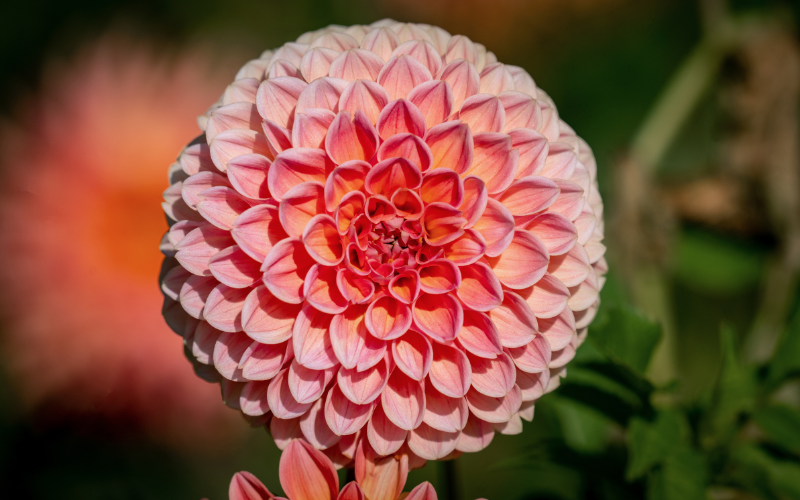
The Hillcrest Suffusion Dahlia boasts stunning petals that form a gradient of deep purples, magentas, and pinks.
The Dahlia flower has soft, velvety petals that enhance its appeal. This variety has big, double blooms with a diameter of up to 8 inches, and it blooms from summer to fall.
| Scientific Name | Dahlia pinnata |
| Native Range | Mexico, Guatemala, and Colombia |
| Flowering Season | Spring |
Apricot Queen Sweet Pea
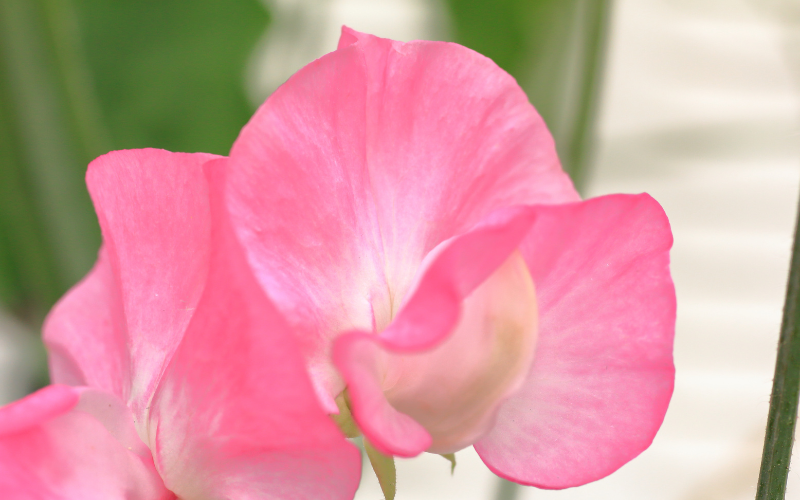
The Apricot Queen Sweet Pea is a stunning flower that boasts a variety of colors including pink, purple, red, white, and blue. Its distinctive coloration makes it stand out from other sweet pea varieties.
Under favorable conditions, they can grow up to 6-8 feet (1.8-2.4 meters) or even more. As a symbol of grace and tenderness, it evokes feelings of joy and serenity.
| Scientific Name | Lathyrus odoratus |
| Native Range | Mediterranean region |
| Flowering Season | Spring or early summer |
Toucan Rose Canna Lily
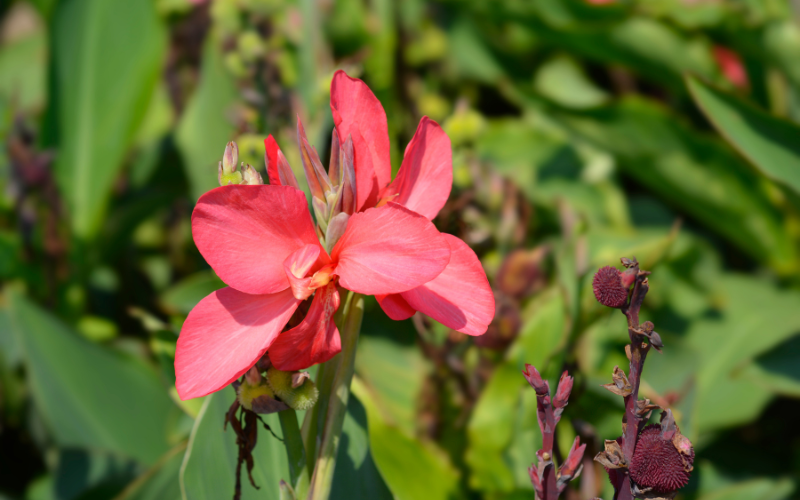
The Toucan Rose Canna Lily is a stunning and vibrant flower with striking pink or rose-colored flowers. The plants typically reach about 3 to 4 feet in height.
The Toucan Rose Canna Lily thrives in warm and sunny conditions. It prefers moist, well-draining soil and plenty of sunlight to flourish. This makes it well-suited for tropical and subtropical climates.
| Scientific Name | Canna ‘Toucan Rose’ |
| Native Range | Caribbean, East and West Africa, Central and South America |
| Flowering Season | Summer |
Sunshine Mimosa
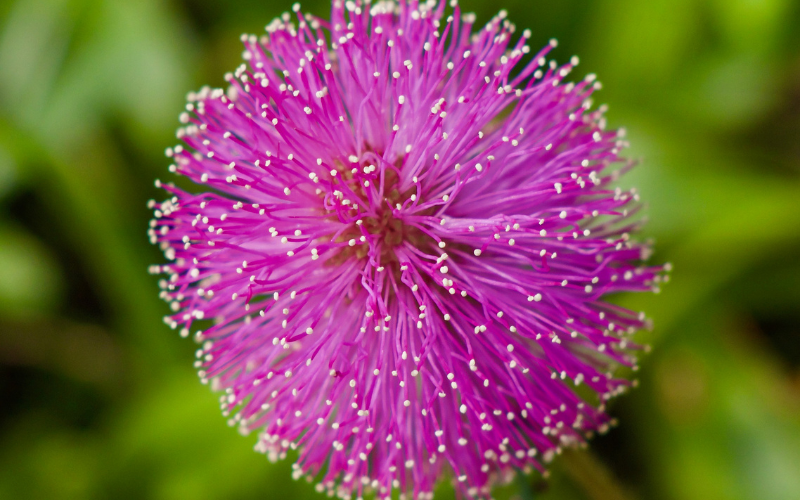
The Sunshine Mimosa is a beautiful flower. It is scientifically known as Mimosa strigillosa. It is native to North and South America. It comes in a range of colors, from soft pink to vibrant purple, adding a pop of color to any outdoor space.
The Sunshine Mimosa prefers bright, sunny locations, thriving in full sun to partial shade. The Sunshine Mimosa is a low-maintenance plant, requiring minimal watering and care once established.
| Scientific Name | Mimosa Strigillosa |
| Native Range | Mexico |
| Flowering Season | Spring through summer |
Summer Breeze Agastache
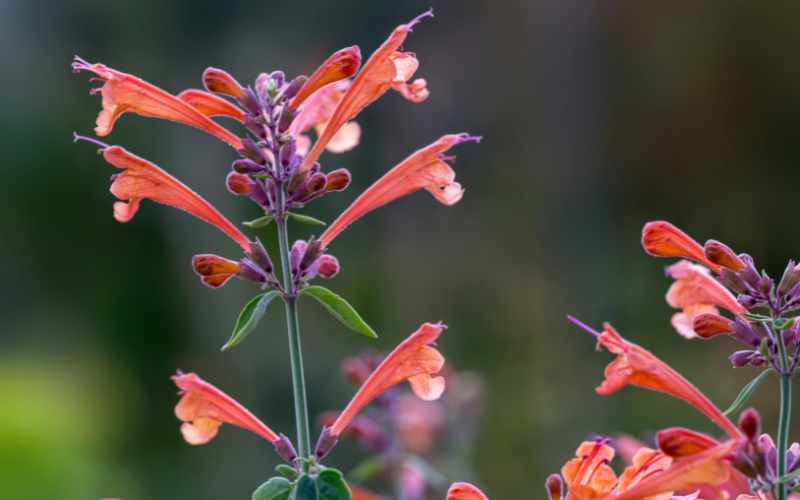
The Summer Breeze Agastache is a stunning flower. It comes in various colors, including shades of pink, purple, orange, and blue. The Summer Breeze Agastache generally thrives in full sun and well-draining soil.
They are considered drought-tolerant once established and are suitable for growing in hot and dry conditions.
| Scientific Name | Agastache hyb. |
| Native Range | North America |
| Flowering Season | Summer to Fall |
Showa-Beni Silky Wisteria

Showa-Beni Silky Wisteria is a beautiful flower. It is also known as Wisteria floribunda ‘Showa-Beni’. It is Native to Japan. The deep pink to-purple hues of the flowers create a mesmerizing display.
The Showa-Beni Silky Wisteria is not only visually stunning but also offers a delightful fragrance, making it a sensory delight.
| Scientific Name | Wisteria brachybotrys |
| Native Range | Japan |
| Flowering Season | Late spring and early summer |
Tower Chamois China Aster

The Tower Chamois China Aster is a truly stunning flower. They produce beautiful, daisy-like flowers with a central disk and colorful ray petals that come in various shades of pink, purple, blue, red, and white.
China Aster plants typically have bushy growth habits and reach a height of about 1 to 3 feet (approximately 30 to 90 cm). China Aster plants prefer full sun and well-draining soil.
| Scientific Name | Callistephus chinensis |
| Native Range | East Asia |
| Flowering Season | Late Summer to Fall |
Salmon Sunset Four O’Clock
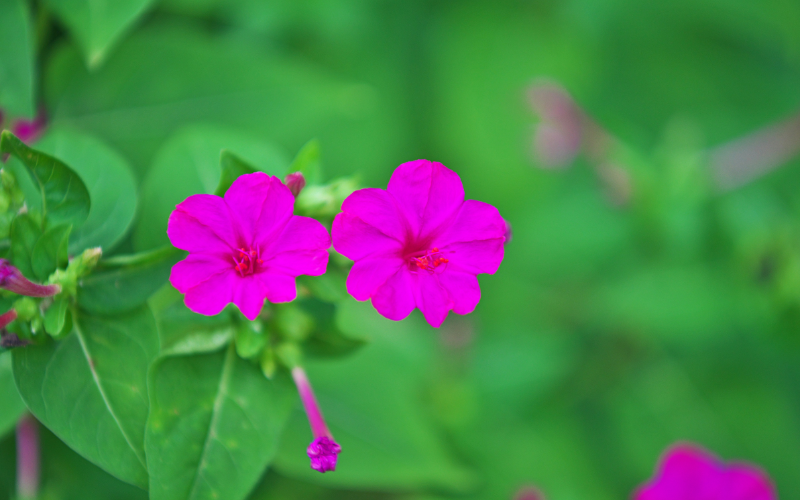
The Salmon Sunset Four O’Clock Flower, also known as Mirabilis jalapa, is a beautiful and distinct plant that is indigenous to the Americas. These plants are bushy and can grow up to 3 feet (approximately 90 cm) tall.
The flowers come in a range of colors, such as pink, white, red, yellow, and purple. They thrive in full sun to partial shade and need regular watering.
| Scientific Name | Mirabilis jalapa |
| Native Range | South America |
| Flowering Season | Summer to Fall |
Ruby Parfait Celosia
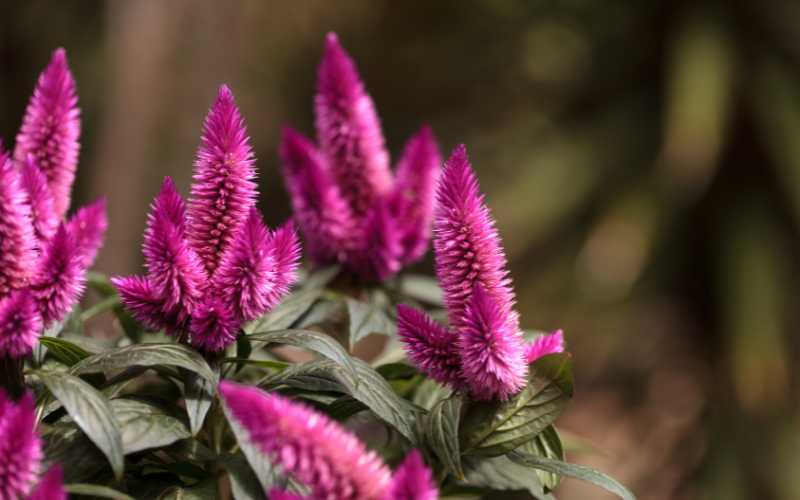
The Ruby Parfait Celosia is a stunning and unique flower. The Ruby Parfait Celosia features striking flower heads with a combination of vivid colors.
The Ruby Parfait Celosia produces plumes with a mix of deep ruby red and pink. It thrives in full sun and well-draining soil, and can tolerate heat and dry conditions.
| Scientific Name | Celosia argentea spicata |
| Native Range | West and Central Africa, and Southeast Asia |
| Flowering Season | Late spring to early summer and continue blooming into the fall |
Rose Bon Bon Cosmos
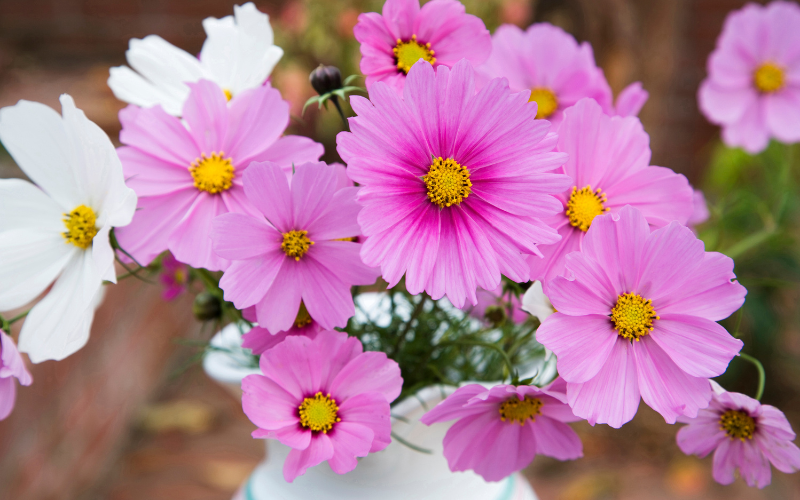
Rose Bon Bon Cosmos is a beautiful flower. The flowers of Cosmos bipinnatus are typically daisy-like and come in various colors, including white, pink, magenta, and lavender.
These flowers bloom in late summer and continue to thrive well into the fall, making them a wonderful choice. The flowers are often large and full, creating a show-stopping display in flower beds or containers.
| Scientific Name | Cosmos bipinnatus |
| Native Range | Mexico |
| Flowering Season | Early summer to fall |
Pomponette English Daisy
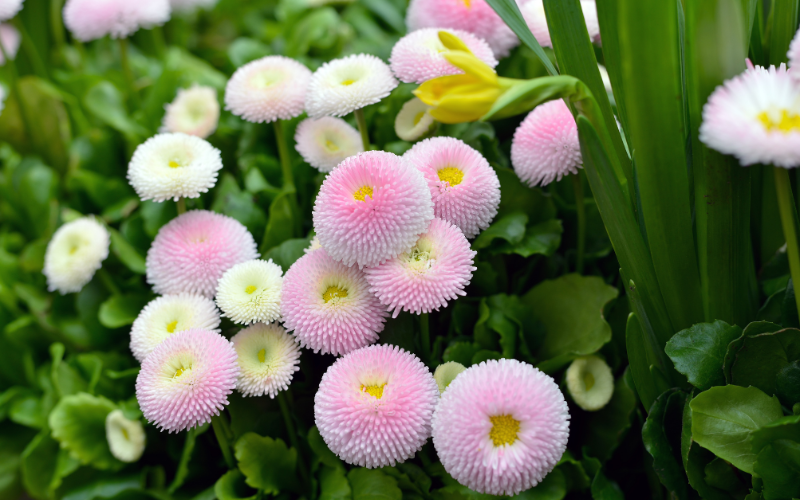
The Pomponette English Daisy, also known as Bellis perennis, is a charming and delicate flower that is native to Europe. The small flowers feature white or pink petals, sometimes with a hint of red, and a bright yellow center at the base.
The Pomponette English Daisy symbolizes innocence and purity. Its delightful fragrance adds sweetness to any garden space.
| Scientific Name | Bellis perennis |
| Native Range | Western, Central and Northern Europe |
| Flowering Season | Spring and Summer |
Pink Paeony Poppy
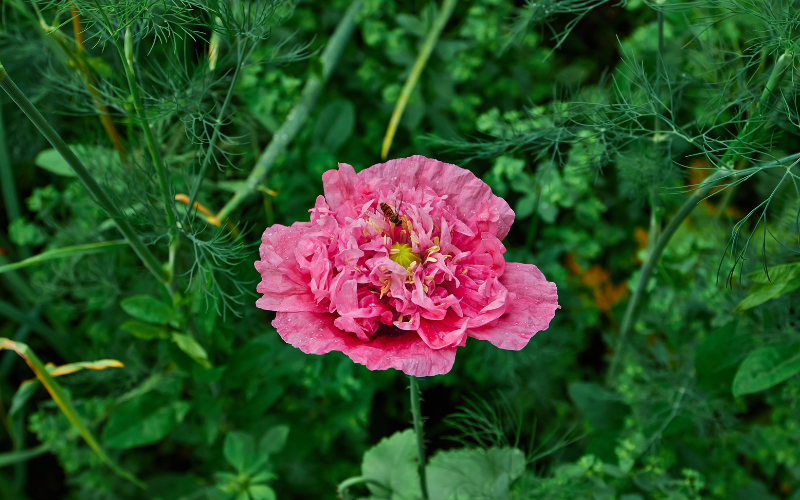
The Pink Paeony Poppy is a beautiful flower. The Pink Peony Poppy features large, double-petaled flowers that closely resemble peonies, hence the name “Pink Peony.”
Pink Peony Poppies are known for their vibrant and eye-catching pink blooms that can reach up to 4-6 inches (10-15 cm) in diameter. These poppies are generally easy to grow from seeds and thrive in full sun and well-draining soil.
| Scientific Name | Papaver somniferum |
| Native Range | Europe and Asia |
| Flowering Season | Spring |
A Shropshire Lad
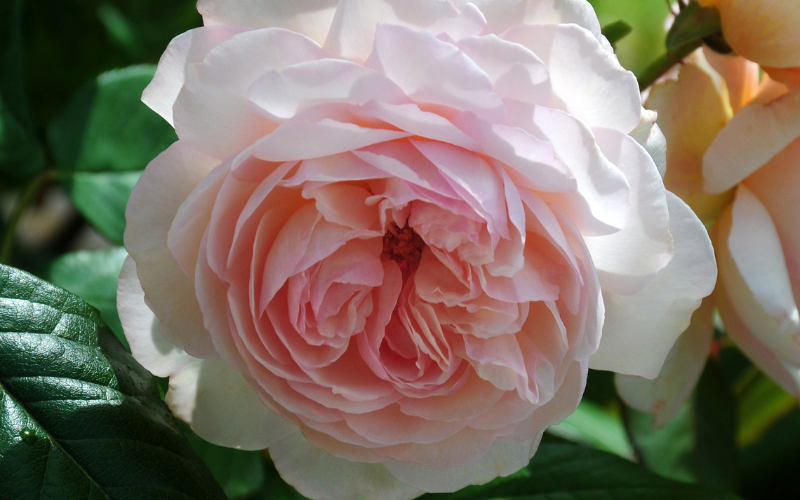
The stunning Shropshire Lad, scientifically known as Pulsatilla vulgaris, has cup-shaped flowers filled with petals that gradually fade from a soft peachy pink to a pale, silvery pink.
The plant’s flowering period is from late spring to early summer. It has an upright, bushy habit and can grow up to 3-4 feet (90-120 cm) in height and spread.
| Scientific Name | Pulsatilla vulgaris |
| Native Range | Europe and the British Isles |
| Flowering Season | Late Spring to Early Summer |
Snapdragon
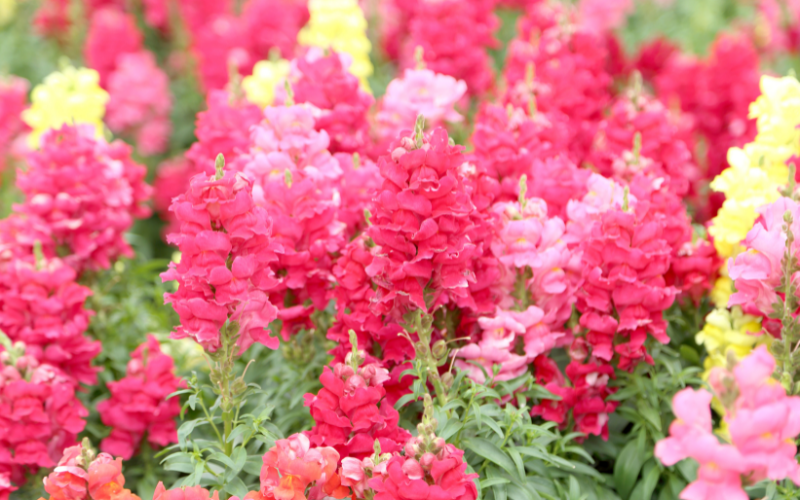
The Snapdragon is a beautiful flower. It is scientifically known as antirrhinum. Snapdragon flowers come in a wide range of colors, including various shades of red, orange, pink, purple, yellow, and white.
They are often planted for fall or early spring blooms in the spring or late summer. They can sometimes bloom in mild winter climates. They prefer full or partial sunlight but can tolerate some shade.
| Scientific Name | Antirrhinum majus |
| Native Range | North Africa and northwards as far as southern France |
| Flowering Season | Spring to Fall |
Apricot Lemonade Cosmos
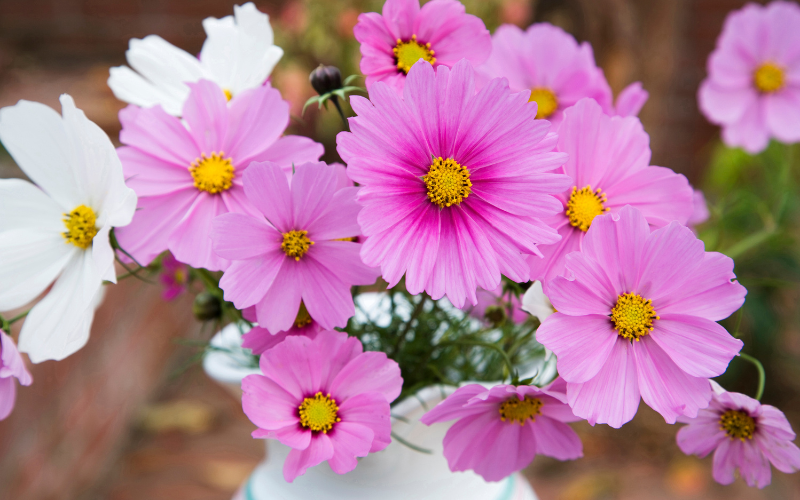
The Apricot Lemonade Cosmos is a stunning and unique flower. It is native to Mexico. The flowers are usually 2 to 4 inches (5 to 10 cm) in diameter. The Apricot Lemonade Cosmos flowers are easy to grow.
They don’t typically require reproduction, as they can grow well in less fertile soil. The flowers typically bloom from early summer until the first frost in the fall.
| Scientific Name | Cosmos bipinnatus |
| Native Range | Mexico |
| Flowering Season | Late Spring to Frost |
Atlantic Pigeon Wings

The Atlantic Pigeon Wings is a beautiful flower. It is scientifically known as Clitoria mariana. It is native to America. It typically blooms from late spring through early fall. The Atlantic Pigeon Wings Flower is a medicinal plant that typically grows in sandy and rocky coastal areas, showcasing its resilience in harsh and salty environments.
Its beautiful blooms not only add a touch of beauty to the landscape but also attract a variety of pollinators, including bees and butterflies.
| Scientific Name | Clitoria mariana |
| Native Range | United States |
| Flowering Season | Late Spring Through Early Fall |
Petunia
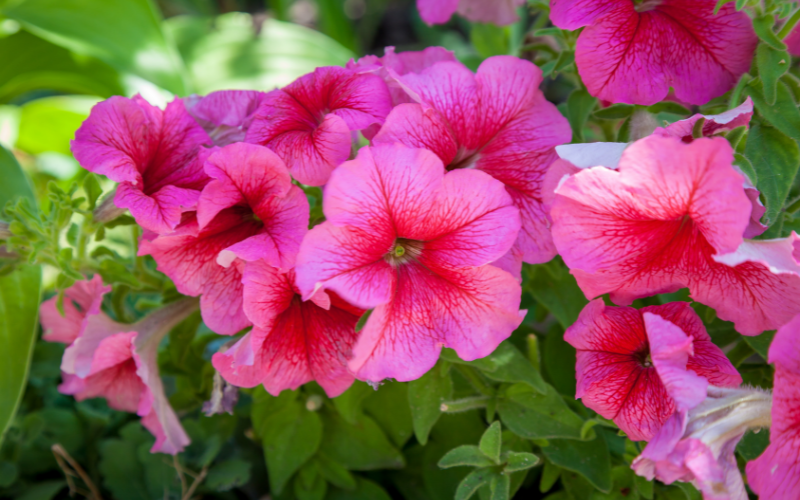
The Petunia is a stunning flower. It is native to South America. The Petunias are available in a wide range of colors, including shades of purple, pink, red, white, yellow, and even bi-color varieties.
With proper care and maintenance, petunias can bloom profusely throughout the summer months. The Petunias can have a trailing or spreading growth habit, making them suitable for hanging baskets, window boxes, and containers.
| Scientific Name | Petunia ×atkinsiana |
| Native Range | South America |
| Flowering Season | Spring |
Beardtongue
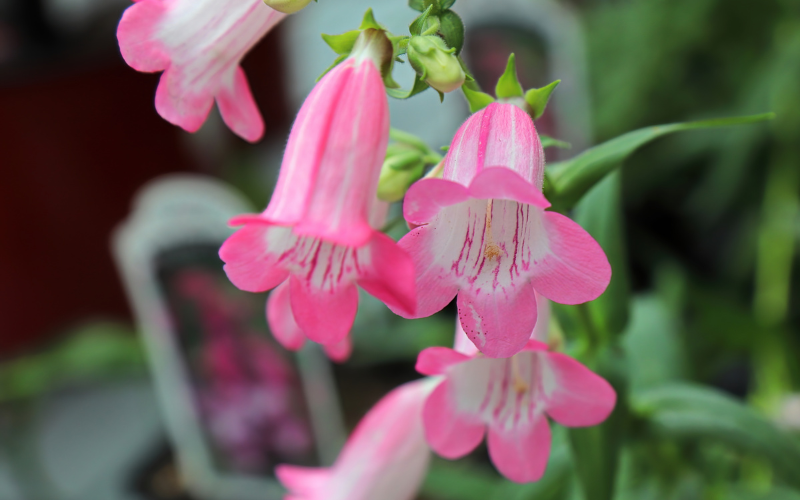
The Beardtongue is a stunning and unique flower. It is scientifically known as Penstemon. It is native to North and Central America. The flowers come in a wide range of colors, including shades of blue, purple, pink, red, and white, depending on the species and variety.
Beardtongues generally thrive in full sun to partial shade. They often do best with at least 6 hours of sunlight per day. Beardtongue is a low-maintenance plant that can survive storms and harsh weather conditions.
| Scientific Name | Penstemon |
| Native Range | United States |
| Flowering Season | Mid-Spring to Early Summer |
Catchfly
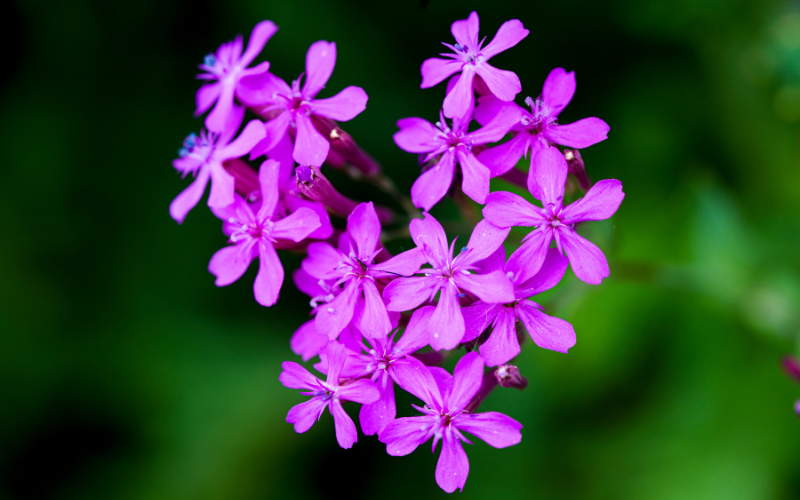
Catchfly is a beautiful flower. It is scientifically known as Silene armeria. It is native to Europe and Asia. The flowers come in a range of shades of pink, red, and white. Catchfly species can vary in size and growth habits.
Some are low-growing ground covers, while others are upright and can reach up to 3 feet (1 meter) in height. Catchfly species prefer full sun to partial shade. They typically thrive in locations with ample sunlight.
| Scientific Name | Silene gallica |
| Native Range | Europe and Asia |
| Flowering Season | Late Spring or Early Summer |
Coral Vine
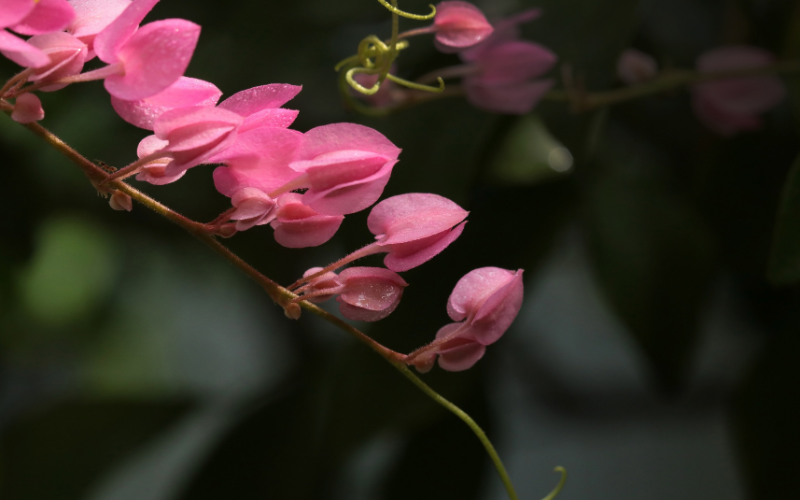
The Coral Vine is a mesmerizing flower. It is scientifically known as Antigonon leptopus. It is native to Mexico. The Coral vine is known for its profusion of small, tubular, and five-petaled flowers that are typically pink or coral in color.
The Coral vine is a fast-growing, climbing vine that can reach lengths of up to 40 feet (12 meters) or more. Coral vine thrives in full sun, although it can tolerate partial shade. It requires at least 6 hours of sunlight each day to produce the best blooms.
| Scientific Name | Antigonon leptopus |
| Native Range | Mexico |
| Flowering Season | Throughout the Year |
Divine Pink Impatiens
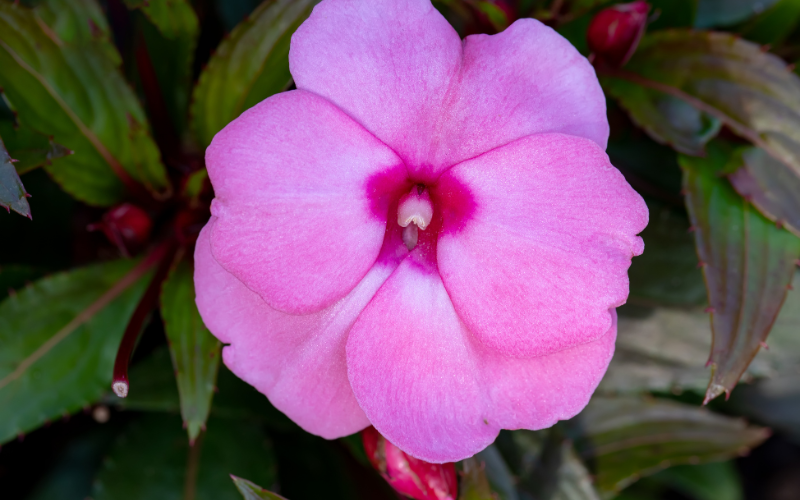
Divine Pink Impatiens is a beautiful flower. It is native to East Africa. Impatiens are bushy, low-growing plants that typically reach a height of 6 to 24 inches (15 to 60 cm).
They have a spreading growth habit, making them well-suited for use as bedding plants or in containers. “Divine Pink” Impatiens prefer partial to full shade. They thrive in locations with dappled sunlight or indirect light.
| Scientific Name | Impatiens walleriana |
| Native Range | Africa and Asia |
| Flowering Season | Late Spring to First Frost |
Belladonna Lily
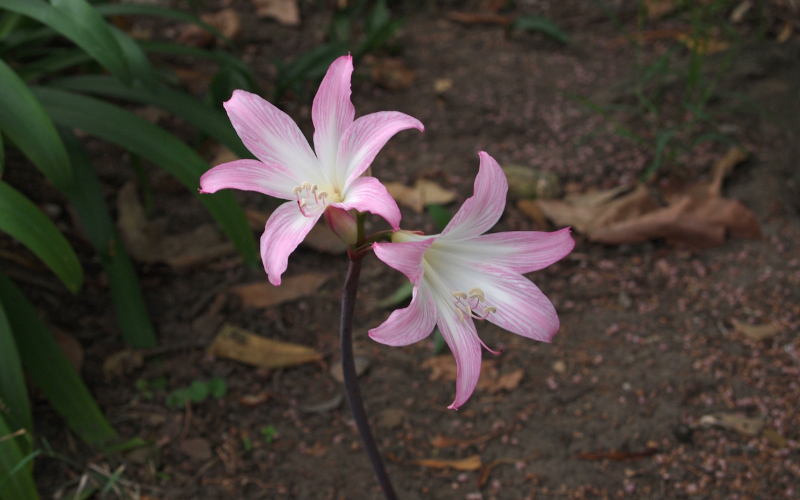
The Belladonna Lily is an exquisite flower. It is scientifically known as Amaryllis belladonna. It is native to South Africa. It blooms in late summer or early autumn.
Belladonna Lilies thrive in full sun to partial shade. They require plenty of sunlight to produce healthy blooms. These lilies can be grown in pots, and gardeners in cooler climes can enjoy their beauty and scent.
| Scientific Name | Amaryllis belladonna |
| Native Range | South Africa |
| Flowering Season | Late Summer or Early Autumn |
Wax Begonia
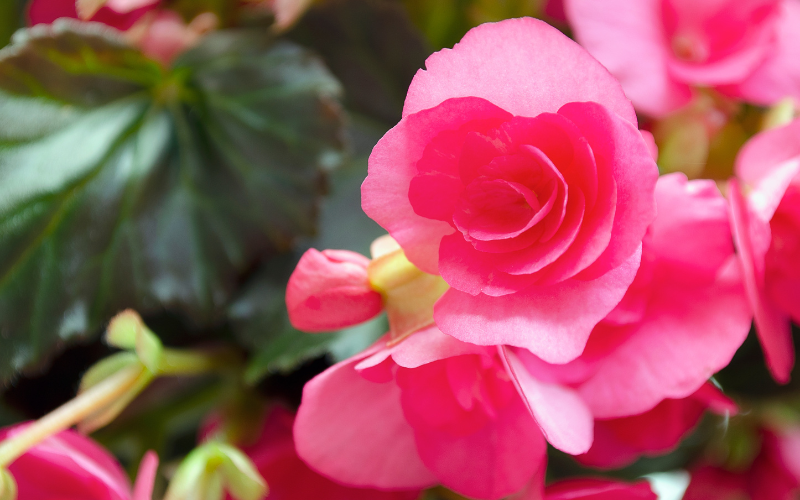
Wax Begonia is a beautiful flower. It is scientifically known as Begonia semperflorens. Wax Begonias typically reach a height of 6 to 12 inches (15-30 cm). These blooms come in various shades, including red, pink, white, and sometimes even bi-colored.
Wax Begonias bloom from late spring through the summer and into early fall. These plants thrive in partial shade to full sun.
| Scientific Name | Begonia x semperflorens-cultorum |
| Native Range | South America |
| Flowering Season | Late spring or early summer well into the fall |
Bougainvillea
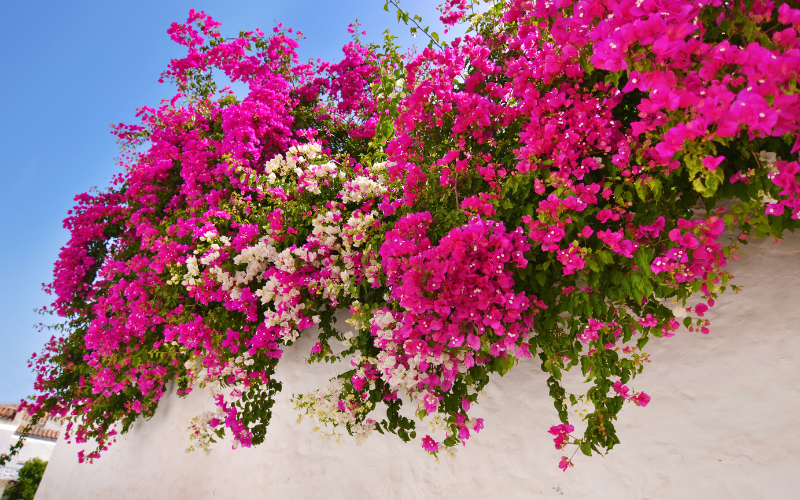
Bougainvillea is a lovely flower. It is native to South America. It comes in vibrant shades of pink, purple, red, and orange. Bougainvillea thrives in full sun and well-drained soil. It prefers warm and tropical climates and can be damaged by frost.
It blooms from late spring through early autumn. The Bougainvillea flower never fails to captivate and leave a lasting impression.
| Scientific Name | Bougainvillea |
| Native Range | South America, Brazil, West to Peru, and Argentina |
| Flowering Season | Throughout the year |
Moss-Rose
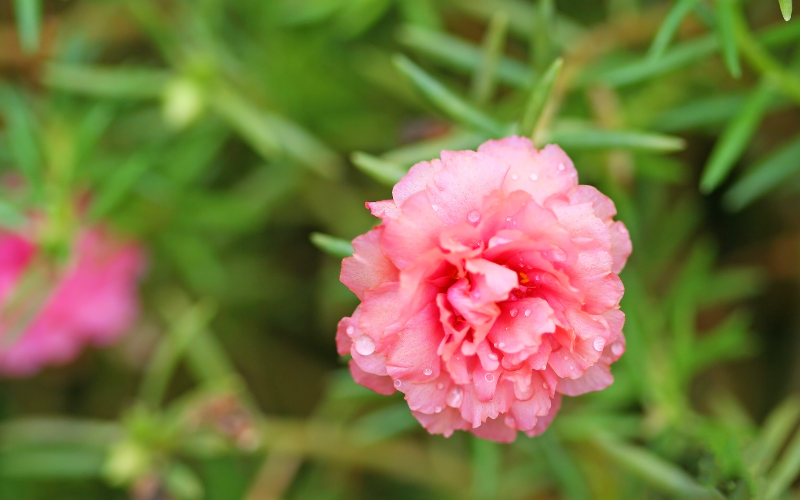
Moss-Rose is a delightful and low-growing flower. It is scientifically known as Portulaca grandiflora. It is native to South America. Moss-Rose is a small, trailing plant that typically reaches a height of 6 to 8 inches (15 to 20 centimeters) with a spread of 6 to 12 inches (15 to 30 centimeters).
It comes in a wide range of colors, including shades of pink, red, orange, yellow, and white. It blooms throughout the summer months.
| Scientific Name | Portulaca grandiflora |
| Native Range | Argentina, Southern Brazil, and Uruguay |
| Flowering Season | Summer to the first frost of the fall |
Mandevilla
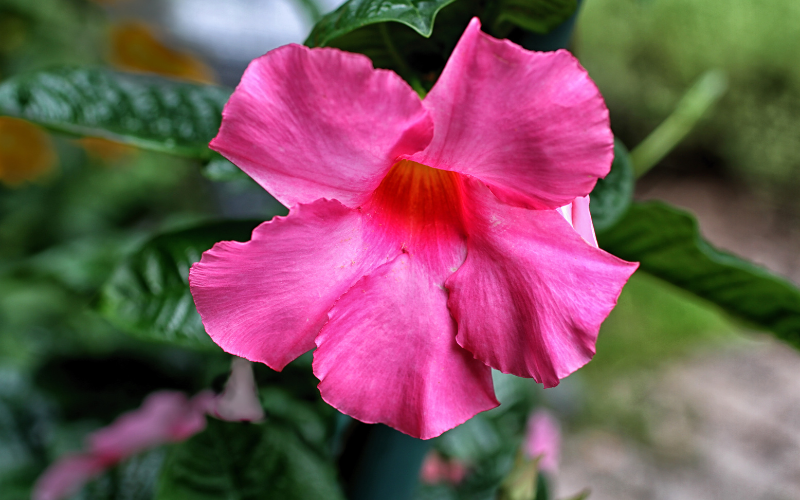
The mandevilla is a stunning flower. It is native to South America. The flowers come in various shades of pink, red, white, and yellow. The flowers typically measure 2 to 4 inches (5 to 10 centimeters) in diameter.
Mandevilla is known for its prolific and continuous blooming during the warm months, typically from late spring through early fall. It prefers full sun to partial shade, well-draining soil, and a warm, humid climate.
| Scientific Name | Mandevilla boliviensis |
| Native Range | Bolivia and Ecuador |
| Flowering Season | Summer, Fall |
Lenten Rose
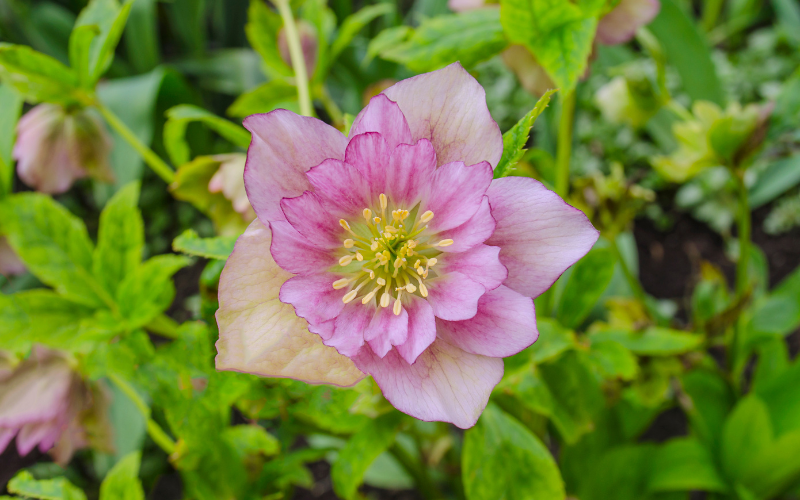
The Lenten Rose is a lovely flower. It is scientifically known as Helleborus Orientalis. It is native to Europe and Asia. The flowers can measure 2 to 3 inches (5 to 7.5 centimeters) in diameter.
The flowers come in a wide range of colors, including white, green, pink, purple, and deep maroon. The flowers bloom in late winter to early spring. It prefers well-draining soil and regular moisture but can tolerate drought once established.
| Scientific Name | Helleborus xhybridus |
| Native Range | Northeastern Greece, northern and northeastern Turkey, Caucasian Russia |
| Flowering Season | Late-winter or early-spring |
Alyssum
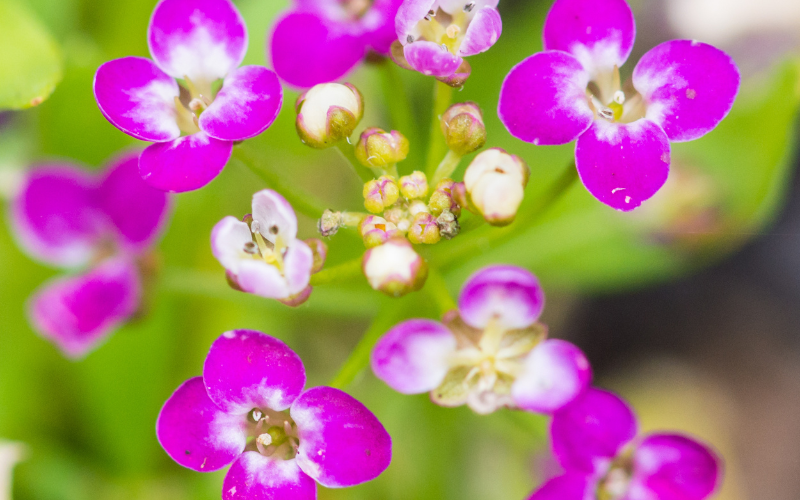
Alyssum is a charming flower. It is scientifically known as Lobularia maritima. They typically reach a height of 4 to 6 inches (10 to 15 centimeters) and can spread up to 12 inches (30 centimeters).
The flowers bloom from spring through early summer and sometimes even into the fall in cooler climates. It thrives in full sun or partial shade. It prefers well-draining soil and is relatively drought-tolerant once established.
| Scientific Name | Lobularia maritima |
| Native Range | Europe, Asia, and Northern Africa |
| Flowering Season | Spring, Fall |
Camellia
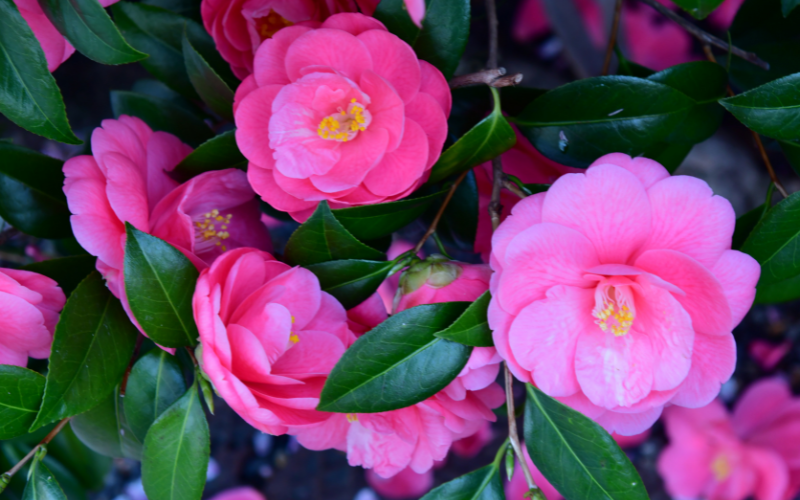
Camellia is a beautiful flower. It is native to East Asia. The flowers come in various colors, including shades of white, pink, and red. Camellias can bloom from late fall through early spring.
It thrives in well-draining, acidic soil with a slightly shady or filtered sun location. They are sensitive to harsh sunlight and require protection from hot afternoon sun.
| Scientific Name | Camellia japonica |
| Native Range | Asia |
| Flowering Season | Late fall to mid-spring |
Dianthus
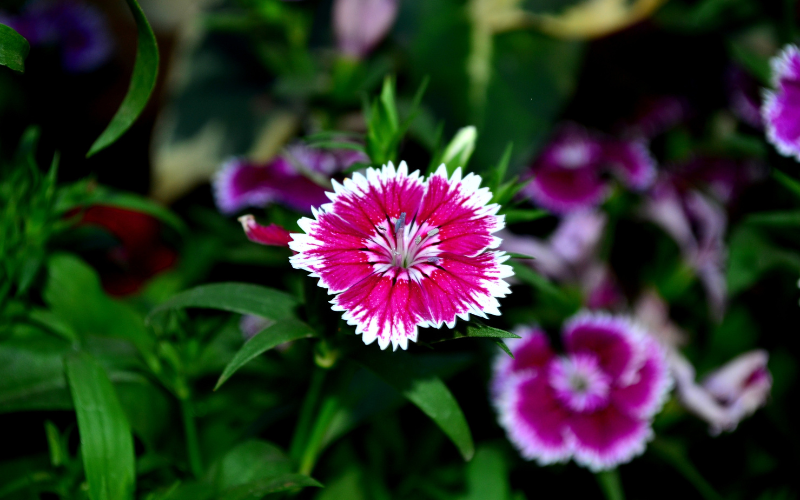
Dianthus is a gorgeous flower. It is native to Europe and Asia. The flowers generally bloom from late spring to early summer. They come in a wide range of colors, including pink, red, white, and purple.
Dianthus is a versatile plant that can be grown in gardens, borders, rock gardens, containers, and even as a cut flower. It prefers well-draining soil and full sun, although it can tolerate some light shade.
| Scientific Name | Dianthus caryophyllus |
| Native Range | Europe and Asia |
| Flowering Season | Late spring to early summer |
Chenille
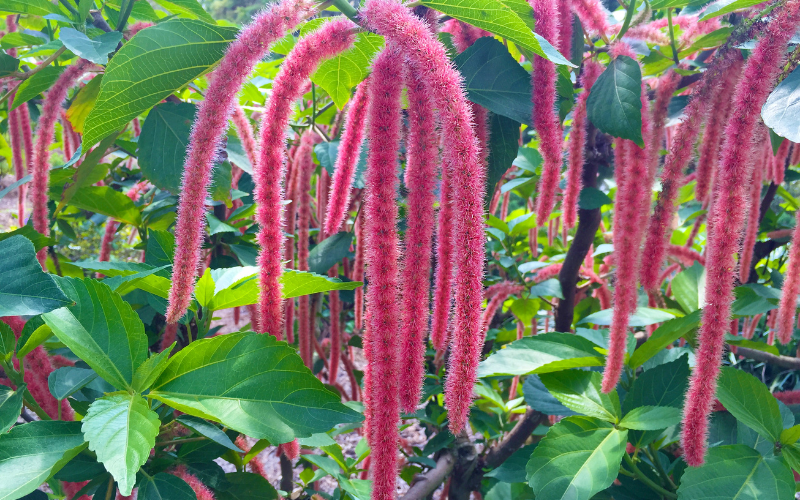
Chenille is a charming flower. It is also known as the Red-Hot Cattail or Foxtail. It is native to the tropical regions of Southeast Asia. The flowers can reach lengths of up to 18 inches (45 cm) or more.
Chenille Plants typically bloom throughout the warm months of the year. Chenille Plants thrive in warm, humid conditions. They require well-draining soil and bright, indirect sunlight.
| Scientific Name | Acalypha hispida |
| Native Range | Philippines and New Guinea |
| Flowering Season | Throughout the year |
Pink Lily of the Valley
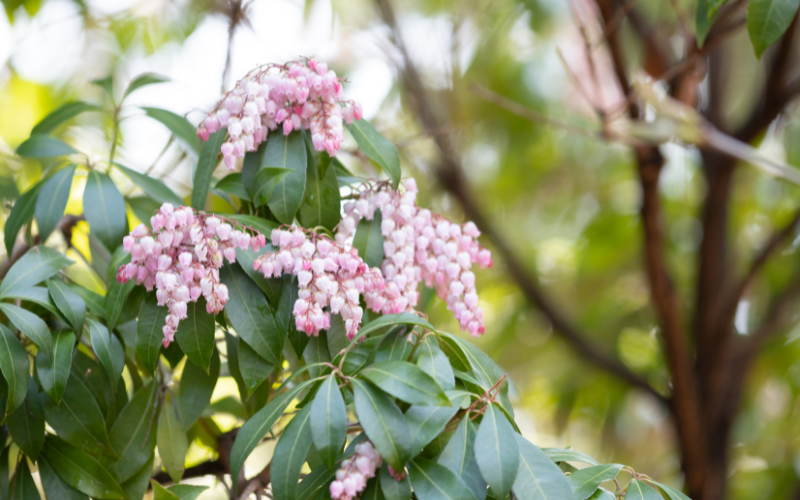
The pink Lily of the Valley is a beautiful flower. It is also known as Convallaria majalis. The flowers are usually white, although there are variations with pink. Pink Lily of the Valley typically blooms in late spring.
This plant prefers shady to partially shady woodland environments with well-draining soil.
| Scientific Name | Convallaria majalis |
| Native Range | Asia and Europe |
| Flowering Season | Spring, Summer |
